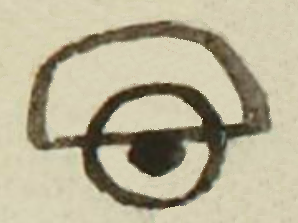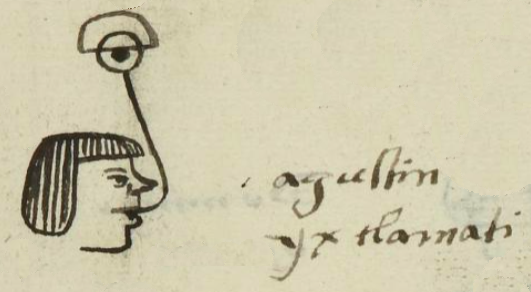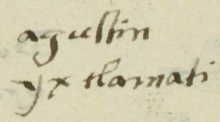Ixtlamati (MH624r)
This black-line drawing of the simplex glyph for the personal name Ixtlamati ("He is Wise") is attested here as a man’s name. The glyph is a human eye (ixtli) drawn in a way fairly close to the pre-contact starry-eye style. It is a phonetic indicator that the name starts with Ix-, but it also ties in semantically to the kind of knowledge the wise person has--gained from experiencing things with his own eyes.
Stephanie Wood
Vision and knowledge have a close relationship. The name Ixtlamati seems to derive from the verb tlamati (also spelled tlamahti, with the glottal stop, “to know something” or to "practice trickery or sorcery." However, the added translation of sorcery and trickery reveals a Christian bias on the part of the friar Alonso de Molina. At the root of tlamati is the verb mati, to know. He explains how iximati can become imati, to manage cleverly or create skillfully; and this compares to mati (to know). Imati involves knowing through seeing, much like conocer might indicate in Spanish, and mati is "to know" as in saber in Spanish. In both the verbs starting ix- or i-, the sign for eye is a semantic indicator for a place of wisdom. According to Thouvenot, imati (which is related to ixtlamati) connects to an empirical knowledge gained through experience by witnessing things with one's eyes, and mati makes reference to an internal, abstract being that has the capacity to think. [See his article: "Imágenes y escritura entre los Nahuas del inicio del XVI," Estudios de Cultura Náhuatl 41 (2010), esp. pp 178–181. My rough translation to English.]
This glyph for the verb Ixtlamati is nearly identical to one that is glossed Tlamauh (see below). This underscores the relationship between the puzzling Tlamao/Tlamauh glyphs and the meaning of ixtlamati or tlamati, as opposed to tlamauhtli. Of course, the European assessment of trickery with tlamauh is not terribly far from the European association between tlamauhtli and "crazed." In all cases, the reader must keep in mind filters and biases.
Stephanie Wood
agustin
yxtlamati
Agustín Ixtlamati
Stephanie Wood
1560
Jeff Haskett-Wood
eyes, ojos, conocimiento, knowledge, visión, wisdom, sabiduría, Tlamao, tlamauh

ixtlamati, a wise man, one who uses reason and has experience, https://nahuatl.wired-humanities.org/content/ixtlamati
tlamati, to know something, or to know magic/trickery, https://nahuatl.wired-humanities.org/content/tlamati
tlamauh, wise one, knowledgeable person, or possibly sorcerer, https://nahuatl.wired-humanities.org/content/tlamauh
tlamauh(tli), crazed, berzerk, or infected, https://nahuatl.wired-humanities.org/content/tlamauhtli
ix(tli), eye, https://nahuatl.wired-humanities.org/content/ixtli
El es Sabio
Stephanie Wood
Matrícula de Huexotzinco, folio 624r, World Digital Library, https://www.loc.gov/resource/gdcwdl.wdl_15282/?sp=330st=image.
This manuscript is hosted by the Library of Congress and the World Digital Library; used here with the Creative Commons, “Attribution-NonCommercial-ShareAlike 3.0 License” (CC-BY-NC-SAq 3.0).











